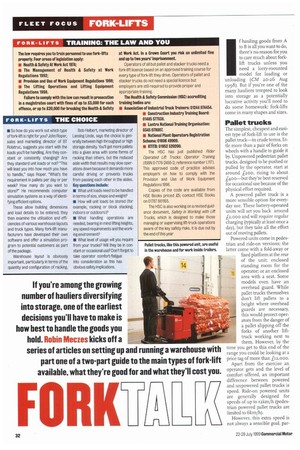FORK - LIFTS THE CHOICE
Page 34

If you've noticed an error in this article please click here to report it so we can fix it.
• So how do you work out which type of fork-lift is right for you? John Roper, sales and marketing director of BT Rolatruc, suggests you start with the loads you'll be handling. Are they constant or constantly changing? Are they standard unit loads or not? "This will lead you into how much you have to handle," says Roper. "What's the requirement in pallets per day or per week? How many do you want to store?" He recommends computer simulation systems as a way of identifying efficient options.
These allow building dimensions and load details to be entered; they then examine the utihsation and efficiencies of various warehouse layouts and truck types. Many fork-lift manufacturers have developed their own software and offer a simulation program to potential customers as part of the package.
Warehouse layout is obviously important, particularly in terms of the quantity and configuration of racking. Bob Helbert, marketing director of Lansing Linde, says the choice is generally between high throughput or high storage density. You'll get more pallets into a given area with some forms of racking than others, but the reduced aisle width that results may slow operations down because it demands more careful driving or prevents trucks from passing each other in the aisles. Key questions include: • What unit loads need to be handled in terms of size, shape and weight?
• How will unit loads be stored (for example, racking or block stacking; indoors or outdoors)?
• What handling operations are needed, bearing in mind lifting heights, any speed requirements and the working environment?
• What level of usage will you require from your trucks? Will they be in constant or occasional use? Don't forget to take operator comfort/fatigue into consideration as this has obvious safety implications.








































































































